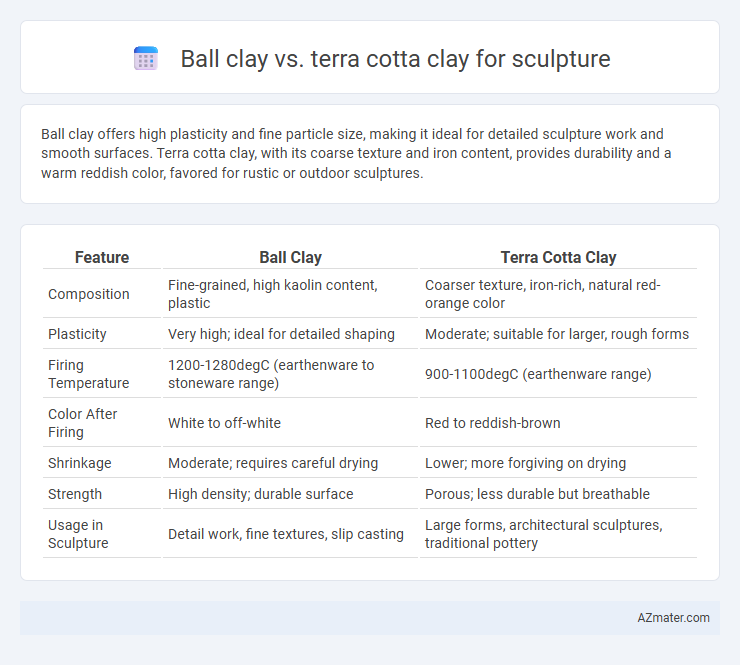Ball clay offers high plasticity and fine particle size, making it ideal for detailed sculpture work and smooth surfaces. Terra cotta clay, with its coarse texture and iron content, provides durability and a warm reddish color, favored for rustic or outdoor sculptures.
Table of Comparison
| Feature | Ball Clay | Terra Cotta Clay |
|---|---|---|
| Composition | Fine-grained, high kaolin content, plastic | Coarser texture, iron-rich, natural red-orange color |
| Plasticity | Very high; ideal for detailed shaping | Moderate; suitable for larger, rough forms |
| Firing Temperature | 1200-1280degC (earthenware to stoneware range) | 900-1100degC (earthenware range) |
| Color After Firing | White to off-white | Red to reddish-brown |
| Shrinkage | Moderate; requires careful drying | Lower; more forgiving on drying |
| Strength | High density; durable surface | Porous; less durable but breathable |
| Usage in Sculpture | Detail work, fine textures, slip casting | Large forms, architectural sculptures, traditional pottery |
Introduction: Understanding Ball Clay and Terra Cotta Clay
Ball clay, known for its fine particle size, high plasticity, and smooth texture, is ideal for detailed and delicate sculpture work, offering excellent moldability and strength after firing. Terra cotta clay, characterized by its coarse texture and rich iron content, produces a warmer, reddish hue and is favored for larger, more rustic sculptures requiring durability and a porous finish. Understanding the distinct properties of these clays helps sculptors select the best material for their artistic and structural needs.
Chemical Composition Differences
Ball clay contains a high percentage of kaolinite, mica, and quartz, resulting in a fine particle size and strong plasticity ideal for detailed sculpting. Terra cotta clay has a higher iron oxide content, which imparts its characteristic reddish-brown color and reduces plasticity compared to ball clay. The chemical composition differences affect firing temperature and shrinkage rates, with ball clay requiring higher temperatures and offering smoother finishes, while terra cotta is more porous and less vitrified.
Physical Properties and Texture
Ball clay exhibits a fine-grained texture with high plasticity and excellent bonding properties, making it ideal for detailed sculpture work and smooth surface finishes. Terra cotta clay features a coarser texture and lower plasticity, resulting in a more porous and earthy appearance that enhances rustic and traditional ceramic sculptures. The physical properties of ball clay contribute to greater strength and durability after firing, whereas terra cotta retains a warm, reddish hue with moderate shrinkage and lower mechanical strength.
Workability and Sculpting Ease
Ball clay offers superior plasticity and smooth texture, making it highly workable and ideal for detailed sculpting with fine precision. Terra cotta clay, while less plastic and more coarse, provides a firmer consistency that supports larger, sturdier forms but may pose challenges in achieving intricate details. Artists often prefer ball clay for ease of manipulation and smooth finish, whereas terra cotta suits projects prioritizing structural strength and traditional aesthetics.
Shrinkage and Drying Behavior
Ball clay exhibits higher plasticity and lower shrinkage rates, typically around 6-8%, making it more stable during drying and firing for detailed sculpture work. Terra cotta clay experiences greater shrinkage, often between 10-12%, which can lead to increased risk of cracking and warping if not carefully managed during drying. The drying behavior of ball clay is more forgiving due to its finer particle size and better moisture retention, whereas terra cotta requires slower, more controlled drying to prevent structural damage.
Firing Temperatures and Results
Ball clay typically fires between 1100degC and 1250degC, producing a smooth, durable, and slightly translucent finish preferred for detailed sculptures. Terra cotta clay fires at lower temperatures, around 900degC to 1100degC, resulting in a porous, reddish-brown, rustic surface ideal for earthy, organic textures in sculptures. Higher firing temperatures of ball clay enhance strength and water resistance, while terra cotta's lower firing range preserves its characteristic warm color and porous structure.
Durability and Strength in Sculpture
Ball clay offers superior plasticity and fine particle size, making it ideal for intricate details in sculpture, but it has lower durability and strength compared to terra cotta clay. Terra cotta clay is known for its robustness and higher firing strength, resulting in a more durable and weather-resistant sculpture. Sculptors seeking long-lasting outdoor pieces often prefer terra cotta for its strength and resistance to cracking under stress.
Aesthetic Qualities: Color and Finish
Ball clay offers a smooth, fine texture with a creamy white to light beige color, enabling sculptures to achieve a polished, detailed finish. Terra cotta clay features a rich, warm reddish-brown hue due to its iron content, providing a rustic, earthy aesthetic that enhances natural surface textures. The choice between ball clay and terra cotta clay significantly influences the visual impact and tactile qualities of sculptural works.
Best Uses and Recommended Applications
Ball clay, known for its fine particle size and high plasticity, is best used in detailed sculpture work requiring smooth finishes and intricate textures, making it ideal for figurines and delicate ornamental pieces. Terra cotta clay, with its coarse texture and porous nature, excels in larger sculptural forms and architectural elements where durability and a rustic, earthy aesthetic are desired. Sculptors often choose ball clay for precision modeling and terra cotta clay for robust, outdoor installations or traditional pottery styles.
Choosing the Right Clay for Your Sculpture Project
Ball clay offers a smooth, plastic texture ideal for detailed and intricate sculpting, while terra cotta clay provides a porous, earthy quality suited for robust, larger forms and outdoor durability. Selecting the right clay depends on the desired finish, with ball clay delivering fine detail and terra cotta excelling in traditional, rustic aesthetics. Consider the firing temperature and shrinkage rate: ball clay generally fires at higher temperatures with less shrinkage, whereas terra cotta requires lower temperatures but may be more prone to cracking.

Infographic: Ball clay vs Terra cotta clay for Sculpture
 azmater.com
azmater.com